Ward A.W. The Cambridge History of British Foreign Policy. 1783-1919. Volume 3
Подождите немного. Документ загружается.

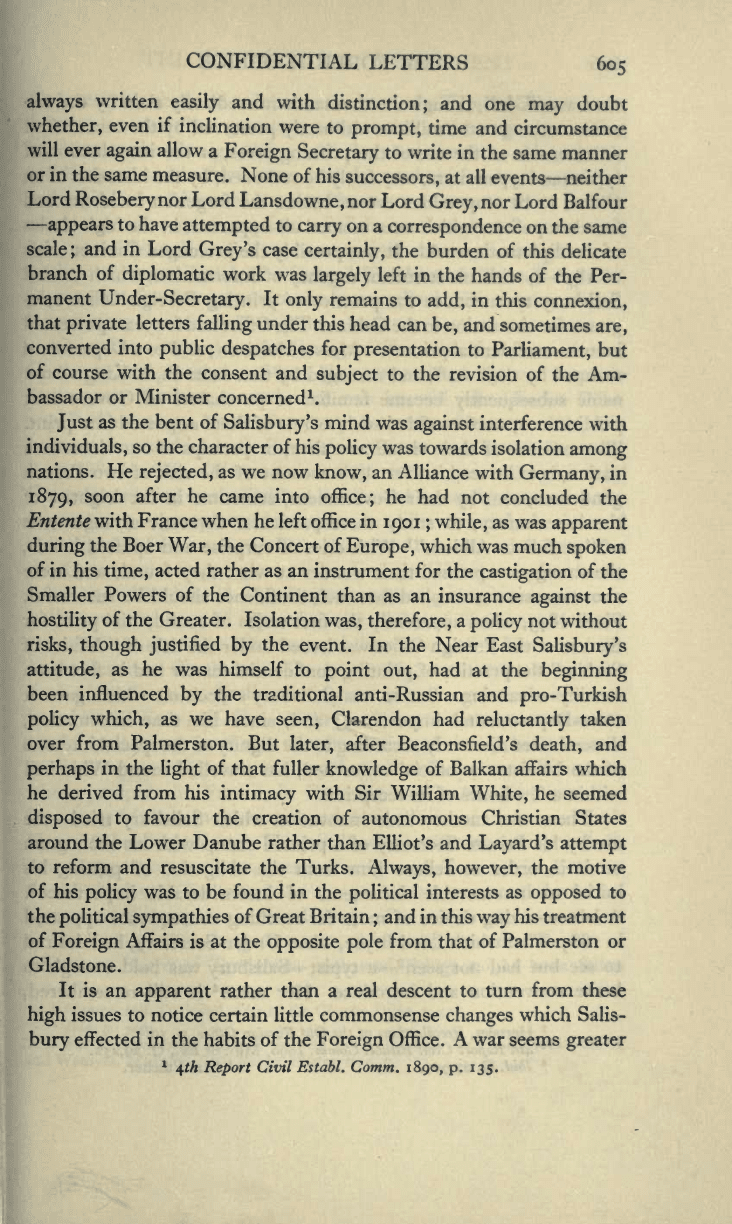
CONFIDENTIAL
LETTERS
605
always
written
easily
and
with
distinction;
and
one
may
doubt
whether,
even
if
inclination
were
to
prompt,
time
and circumstance
will ever
again
allow
a
Foreign
Secretary
to
write
in
the same
manner
or in the
same
measure.
None of
his
successors,
at
all
events
—
neither
Lord
Roseberynor
Lord
Lansdowne,nor
Lord
Grey,
nor
Lord Balfour
—
appears
to
have
attempted
to
carry
on
a
correspondence
on
the
same
scale;
and
in
Lord
Grey's
case
certainly,
the burden
of
this delicate
branch
of
diplomatic
work
was
largely
left
in
the
hands
of
the
Per-
manent
Under-Secretary.
It
only
remains
to
add,
in
this
connexion,
that
private
letters
falling
under
this head
can
be,
and
sometimes
are,
converted
into
public
despatches
for
presentation
to
Parliament,
but
of
course
with
the
consent
and
subject
to the revision
of
the
Am-
bassador
or
Minister
concerned
1
.
Just
as
the bent
of
Salisbury's
mind
was
against
interference
with
individuals,
so
the
character
of
his
policy
was
towards
isolation
among
nations. He
rejected,
as we now
know,
an
Alliance
with
Germany,
in
1879,
soon
after
he
came
into
office;
he
had
not concluded
the
Entente
with
France when he
left office in
1901
; while,
as was
apparent
during
the Boer
War,
the
Concert
of
Europe,
which
was
much
spoken
of in
his
time,
acted
rather as an
instrument
for
the
castigation
of
the
Smaller Powers of
the
Continent than as
an
insurance
against
the
hostility
of
the Greater.
Isolation
was, therefore,
a
policy
not without
risks,
though
justified
by
the
event.
In
the
Near
East
Salisbury's
attitude,
as
he was
himself to
point
out,
had at
the
beginning
been influenced
by
the
traditional anti-Russian
and
pro-Turkish
policy
which,
as we
have
seen,
Clarendon had
reluctantly
taken
over
from
Palmerston. But
later,
after
Beaconsfield's
death,
and
perhaps
in
the
light
of
that fuller
knowledge
of Balkan affairs which
he
derived
from
his
intimacy
with
Sir
William
White,
he seemed
disposed
to favour
the
creation
of
autonomous Christian States
around
the
Lower Danube
rather
than
Elliot's
and
Layard's
attempt
to reform
and
resuscitate the
Turks.
Always,
however,
the
motive
of
his
policy
was to be
found in
the
political
interests
as
opposed
to
the
political
sympathies
of Great Britain
;
and in
this
way
his
treatment
of
Foreign
Affairs
is at the
opposite pole
from
that
of
Palmerston
or
Gladstone.
It
is an
apparent
rather than
a real
descent to turn
from
these
high
issues
to notice
certain little
commonsense
changes
which Salis-
bury
effected in
the habits
of
the
Foreign
Office.
A war
seems
greater
x
4th Report
Civil Establ. Comm.
1890,
p.
135.
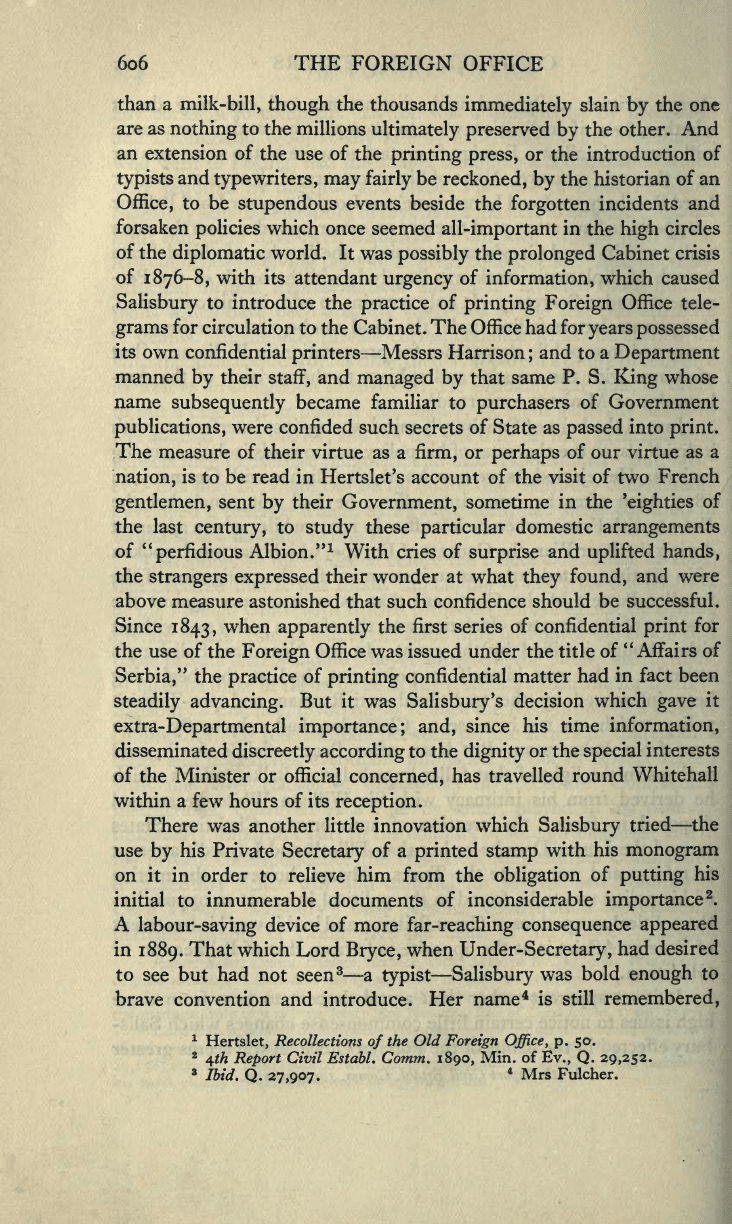
606
THE FOREIGN
OFFICE
than
a
milk-bill,
though
the
thousands
immediately
slain
by
the
one
are as
nothing
to the
millions
ultimately preserved
by
the
other.
And
an
extension
of
the
use of
the
printing
press,
or
the
introduction
of
typists
and
typewriters,
may fairly
be
reckoned,
by
the historian
of
an
Office,
to
be
stupendous
events beside
the
forgotten
incidents
and
forsaken
policies
which
once seemed
all-important
in
the
high
circles
of
the
diplomatic
world.
It was
possibly
the
prolonged
Cabinet
crisis
of
1876-8,
with its
attendant
urgency
of
information,
which caused
Salisbury
to introduce
the
practice
of
printing Foreign
Office
tele-
grams
for
circulation to
the
Cabinet.
The Office
had for
years
possessed
its own
confidential
printers
—
Messrs
Harrison
;
and to
a
Department
manned
by
their
staff,
and
managed
by
that
same P. S.
King
whose
name
subsequently
became familiar
to
purchasers
of
Government
publications,
were
confided such secrets
of
State
as
passed
into
print.
The
measure of
their virtue
as a
firm,
or
perhaps
of our
virtue
as a
nation,
is
to be read in
Hertslet's account
of
the visit
of
two
French
gentlemen,
sent
by
their
Government,
sometime
in
the
'eighties
of
the last
century,
to
study
these
particular
domestic
arrangements
of
"perfidious
Albion."
1
With
cries
of
surprise
and
uplifted
hands,
the
strangers
expressed
their wonder
at
what
they
found,
and were
above
measure
astonished that such confidence
should
be successful.
Since
1843,
when
apparently
the
first
series
of confidential
print
for
the
use
of
the
Foreign
Office was issued under the title
of "Affairs
of
Serbia,"
the
practice
of
printing
confidential
matter
had
in
fact been
steadily
advancing.
But
it was
Salisbury's
decision
which
gave
it
extra-Departmental
importance;
and,
since
his time
information,
disseminated
discreetly
according
to the
dignity
or the
special
interests
of
the
Minister
or official
concerned,
has travelled
round
Whitehall
within
a
few hours
of
its
reception.
There was
another little innovation
which
Salisbury
tried
—
the
use
by
his
Private
Secretary
of a
printed
stamp
with
his
monogram
on
it
in
order
to relieve
him from
the
obligation
of
putting
his
initial to innumerable
documents
of inconsiderable
importance
2
.
A
labour-saving
device
of
more
far-reaching
consequence
appeared
in
1889.
That which Lord
Bryce,
when
Under-Secretary,
had
desired
to see
but
had
not
seen
3
—
a
typist
—
Salisbury
was
bold
enough
to
brave
convention
and
introduce.
Her
name
4
is still
remembered,
1
Hertslet,
Recollections
of
the
Old
Foreign
Office,
p.
50.
2
4th
Report
Civil
Establ.
Comm.
1890,
Min. of
Ev.,
Q.
29,252.
3
Ibid.
Q.
27,907.
*
Mrs Fulcher.
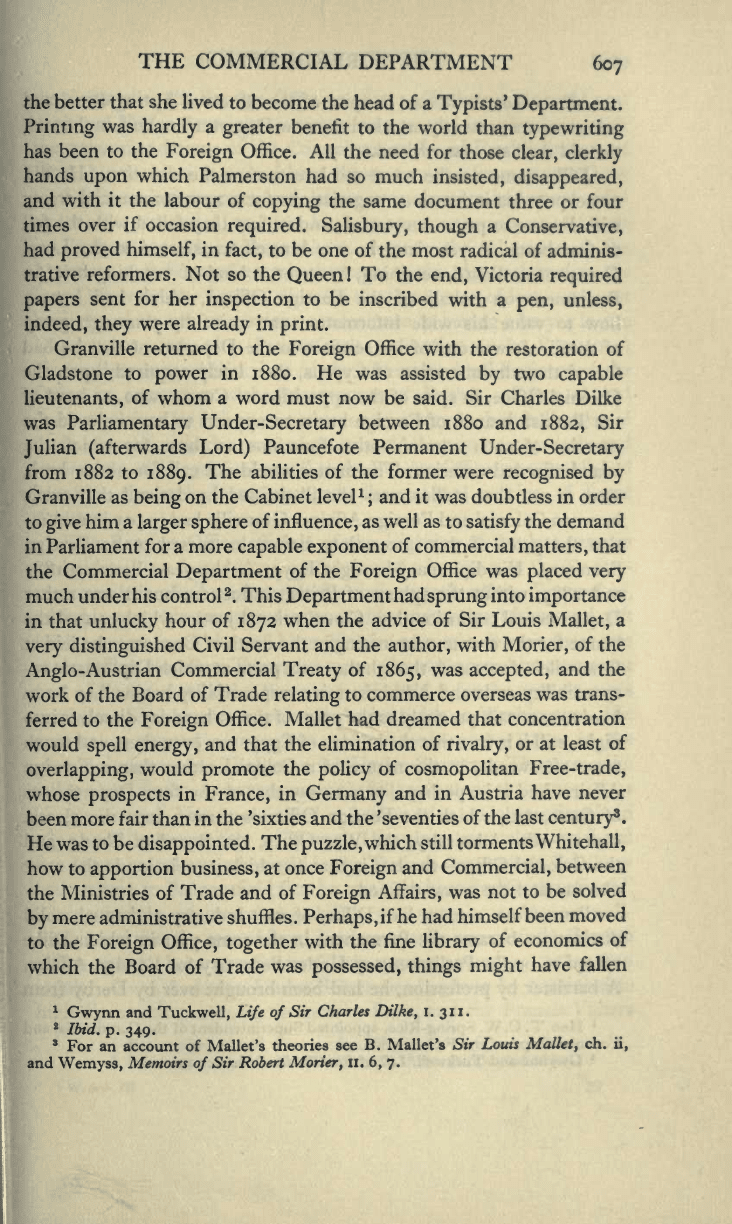
THE
COMMERCIAL
DEPARTMENT
607
the
better
that she
lived
to
become
the head of a
Typists'
Department.
Printing
was
hardly
a
greater
benetit to the world
than
typewriting
has
been to the
Foreign
Office. All
the need for
those
clear,
clerkly
hands
upon
which
Palmerston had so much
insisted,
disappeared,
and
with
it
the
labour of
copying
the
same
document
three
or four
times
over
if
occasion
required.
Salisbury,
though
a
Conservative,
had
proved
himself,
in
fact,
to be
one of
the
most
radical of
adminis-
trative
reformers.
Not
so
the
Queen!
To
the
end,
Victoria
required
papers
sent
for
her
inspection
to be
inscribed
with
a
pen,
unless,
indeed,
they
were
already
in
print.
Granville returned to
the
Foreign
Office
with the
restoration
of
Gladstone
to
power
in
1880. He was
assisted
by
two
capable
lieutenants,
of
whom
a
word must now
be
said. Sir Charles Dilke
was
Parliamentary Under-Secretary
between
1880 and
1882,
Sir
Julian
(afterwards
Lord)
Pauncefote
Permanent
Under-Secretary
from 1882 to
1889.
The abilities
of the former
were
recognised
by
Granville
as
being
on the Cabinet
level
1
;
and
it
was
doubtless
in
order
to
give
him a
larger
sphere
of
influence,
as
well as
to
satisfy
the demand
in
Parliament
for a more
capable exponent
of
commercial
matters,
that
the
Commercial
Department
of
the
Foreign
Office was
placed
very
much under
his control
2
.
This
Department
had
sprung
into
importance
in
that
unlucky
hour
of
1872
when
the
advice
of Sir Louis
Mallet,
a
very distinguished
Civil
Servant
and
the
author,
with
Morier,
of
the
Anglo-Austrian
Commercial
Treaty
of
1865,
was
accepted,
and
the
work
of
the
Board of
Trade
relating
to
commerce overseas
was
trans-
ferred
to the
Foreign
Office.
Mallet
had dreamed that
concentration
would
spell energy,
and
that
the elimination
of
rivalry,
or at least
of
overlapping,
would
promote
the
policy
of
cosmopolitan
Free-trade,
whose
prospects
in
France,
in
Germany
and in Austria
have
never
been more
fair
than
in
the
'sixties
and
the
'seventies
of
the
last
century
3
.
He
was
to
be
disappointed.
The
puzzle,
which
still torments
Whitehall,
how
to
apportion
business,
at
once
Foreign
and
Commercial,
between
the
Ministries
of Trade
and of
Foreign
Affairs,
was
not
to
be
solved
by
mere administrative
shuffles.
Perhaps,
if
he
had himself
been
moved
to
the
Foreign
Office,
together
with the
fine
library
of economics
of
which
the
Board of Trade
was
possessed, things
might
have
fallen
1
Gwynn
and
Tuckwell, Life
of
Sir Charles
Dilke,
i.
311.
2
Ibid.
p. 349.
8
For an
account
of Mallet's
theories
see
B.
Mallet's
Sir
Louis
Mallet,
ch.
ii,
and
Wemyss,
Memoirs
of
Sir
Robert
Morier,
11.
6,
7.
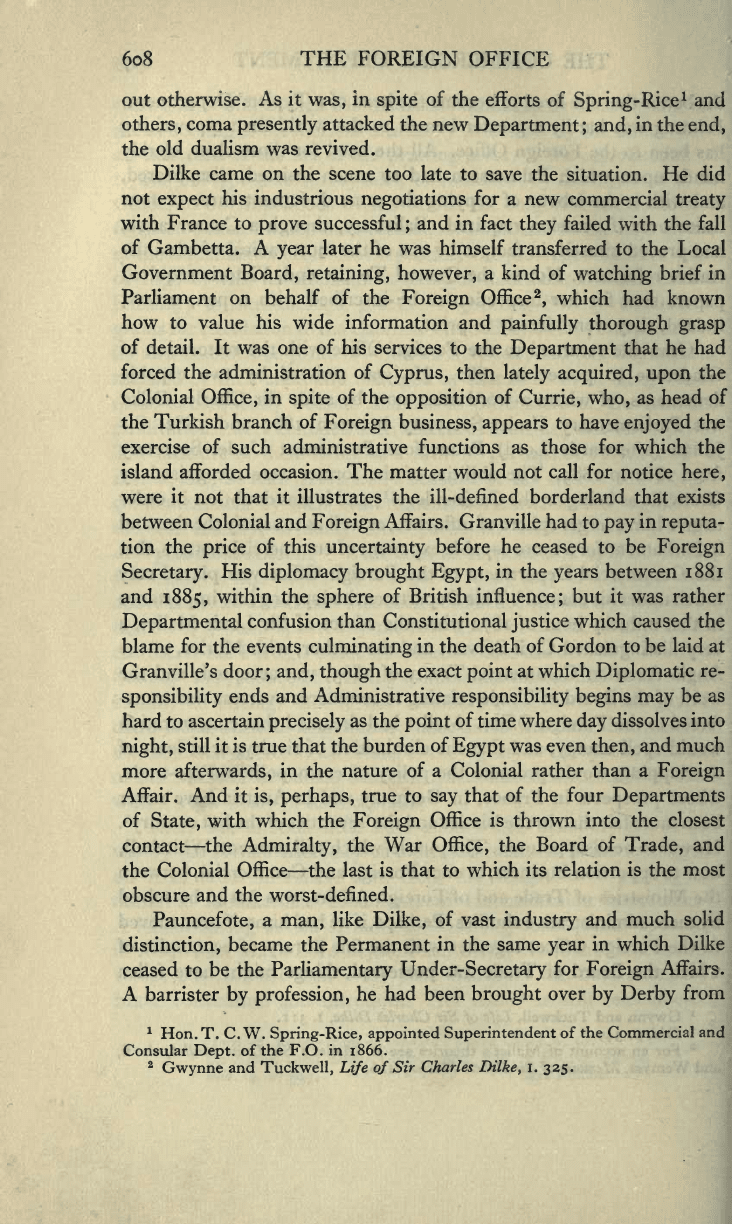
608
THE
FOREIGN
OFFICE
out
otherwise.
As it
was,
in
spite
of
the
efforts of
Spring-Rice
1
and
others,
coma
presently
attacked
the new
Department
;
and,
in
the
end,
the
old dualism was
revived.
Dilke
came
on
the
scene too
late to save the
situation.
He
did
not
expect
his industrious
negotiations
for
a
new
commercial
treaty
with
France
to
prove
successful
;
and in
fact
they
failed
with the
fall
of
Gambetta.
A
year
later he was himself
transferred
to
the
Local
Government
Board,
retaining,
however,
a kind
of
watching
brief
in
Parliament
on
behalf
of
the
Foreign
Office
2
,
which had
known
how
to value
his
wide information and
painfully
thorough
grasp
of
detail.
It
was one
of
his services to
the
Department
that
he
had
forced
the administration
of
Cyprus,
then
lately
acquired,
upon
the
Colonial
Office,
in
spite
of
the
opposition
of
Currie,
who,
as head
of
the
Turkish branch of
Foreign
business,
appears
to
have
enjoyed
the
exercise
of
such
administrative functions
as
those
for which
the
island
afforded occasion. The
matter
would
not
call
for
notice
here,
were
it
not that
it illustrates the
ill-defined borderland
that
exists
between
Colonial
and
Foreign
Affairs. Granville had
to
pay
in
reputa-
tion the
price
of
this
uncertainty
before he ceased
to
be
Foreign
Secretary.
His
diplomacy brought Egypt,
in
the
years
between
1881
and
1885,
within the
sphere
of
British
influence;
but
it
was
rather
Departmental
confusion
than Constitutional
justice
which caused the
blame for
the
events
culminating
in
the death
of Gordon to be
laid
at
Granville's
door;
and,
though
the exact
point
at
which
Diplomatic
re-
sponsibility
ends
and
Administrative
responsibility begins
may
be as
hard
to
ascertain
precisely
as
the
point
of
time
where
day
dissolves into
night,
still it
is
true
that
the
burden
of
Egypt
was even
then,
and much
more
afterwards,
in
the nature
of a Colonial
rather
than
a
Foreign
Affair.
And
it
is,
perhaps,
true to
say
that
of
the
four
Departments
of
State,
with
which the
Foreign
Office is
thrown into
the
closest
contact
—
the
Admiralty,
the
War
Office,
the
Board of
Trade,
and
the
Colonial
Office
—
the last
is
that
to
which
its relation
is
the
most
obscure
and the
worst-defined.
Pauncefote,
a
man,
like
Dilke,
of
vast
industry
and much
solid
distinction,
became
the
Permanent
in
the
same
year
in which
Dilke
ceased
to
be
the
Parliamentary
Under-Secretary
for
Foreign
Affairs.
A
barrister
by profession,
he
had been
brought
over
by Derby
from
1
Hon. T.
C. W.
Spring-Rice,
appointed
Superintendent
of
the Commercial
and
Consular
Dept.
of the
F.O. in 1866.
2
Gwynne
and
Tuckwell,
Life
of
Sir Charles
Dilke,
1.
325.
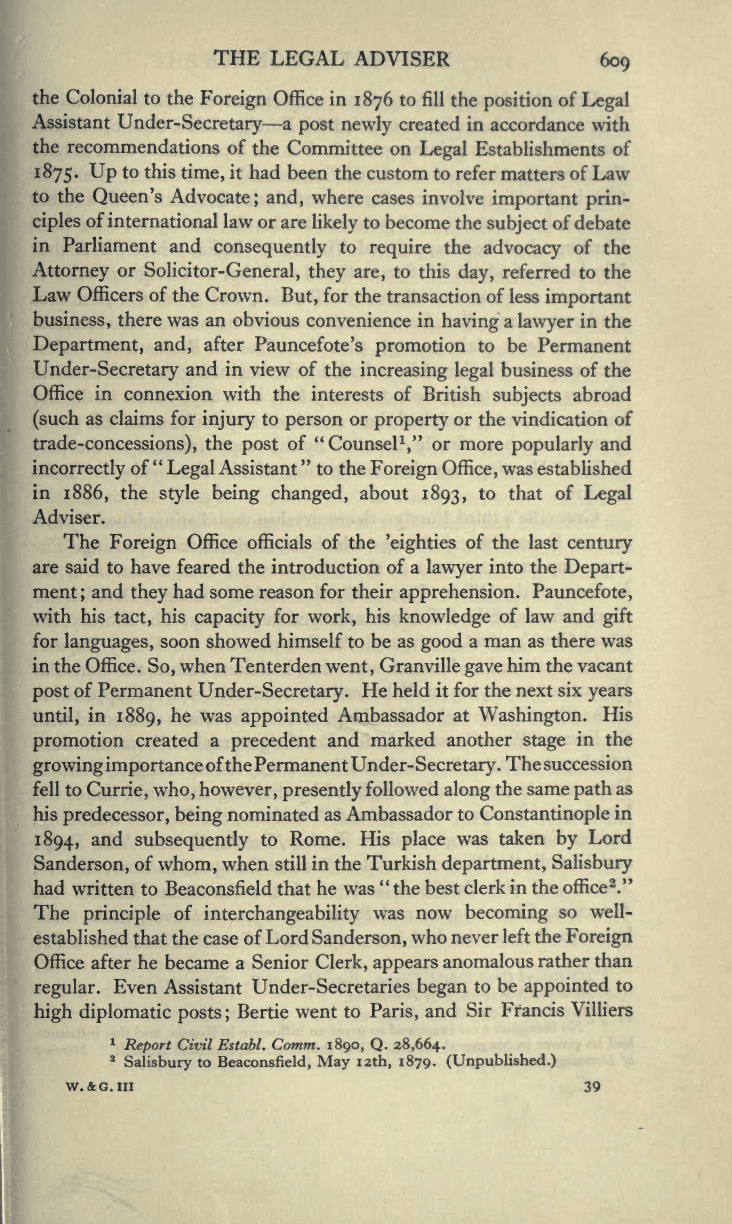
THE
LEGAL
ADVISER
609
the
Colonial
to the
Foreign
Office in
1876
to fill
the
position
of
Legal
Assistant
Under-Secretary
—
a
post
newly
created
in
accordance with
the
recommendations of
the
Committee
on
Legal
Establishments
of
1875.
Up
to this
time,
it
had
been
the custom
to
refer
matters
of Law
to
the
Queen's
Advocate;
and,
where
cases
involve
important prin-
ciples
of
international law or
are
likely
to
become
the
subject
of
debate
in
Parliament and
consequently
to
require
the
advocacy
of
the
Attorney
or
Solicitor-General,
they
are,
to
this
day,
referred
to
the
Law
Officers of
the
Crown.
But,
for
the
transaction
of
less
important
business,
there
was
an
obvious
convenience
in
having
a
lawyer
in
the
Department,
and,
after
Pauncefote's
promotion
to be
Permanent
Under-Secretary
and in
view
of
the
increasing
legal
business of
the
Office
in
connexion with
the
interests
of
British
subjects
abroad
(such
as claims for
injury
to
person
or
property
or
the
vindication
of
trade-concessions),
the
post
of
u
Counsel
1
,"
or
more
popularly
and
incorrectly
of
"
Legal
Assistant
"
to
the
Foreign
Office,
was established
in
1886,
the
style
being
changed,
about
1893,
to that
of
Legal
Adviser.
The
Foreign
Office officials of the
'eighties
of
the last
century
are said
to have feared
the introduction
of a
lawyer
into the
Depart-
ment
;
and
they
had
some reason
for
their
apprehension.
Pauncefote,
with
his
tact,
his
capacity
for
work,
his
knowledge
of law
and
gift
for
languages,
soon showed himself to be
as
good
a
man as
there
was
in
the Office.
So,
when Tenterden
went,
Granville
gave
him
the vacant
post
of Permanent
Under-Secretary.
He
held it
for
the next
six
years
until,
in
1889,
he was
appointed
Ambassador at
Washington.
His
promotion
created
a
precedent
and marked another
stage
in
the
growing
importance
of
the
Permanent
Under-Secretary.
The
succession
fell
to
Currie, who, however,
presently
followed
along
the
same
path
as
his
predecessor,
being
nominated
as Ambassador to
Constantinople
in
1894,
and
subsequently
to
Rome. His
place
was taken
by
Lord
Sanderson,
of
whom,
when still
in
the
Turkish
department,
Salisbury
had
written
to
Beaconsfield that
he
was "the
best
clerk
in
the
office
2
."
The
principle
of
interchangeability
was
now
becoming
so well-
established
that
the
case of
Lord
Sanderson,
who
never left
the
Foreign
Office after
he became a
Senior
Clerk,
appears
anomalous
rather
than
regular.
Even
Assistant
Under-Secretaries
began
to
be
appointed
to
high diplomatic
posts
;
Bertie
went to
Paris,
and
Sir
Francis Villiers
1
Report
Civil Establ.
Comm.
1890,
Q.
28,664.
2
Salisbury
to
Beaconsfield,
May
12th,
1879.
(Unpublished.)
w. &G. in
39
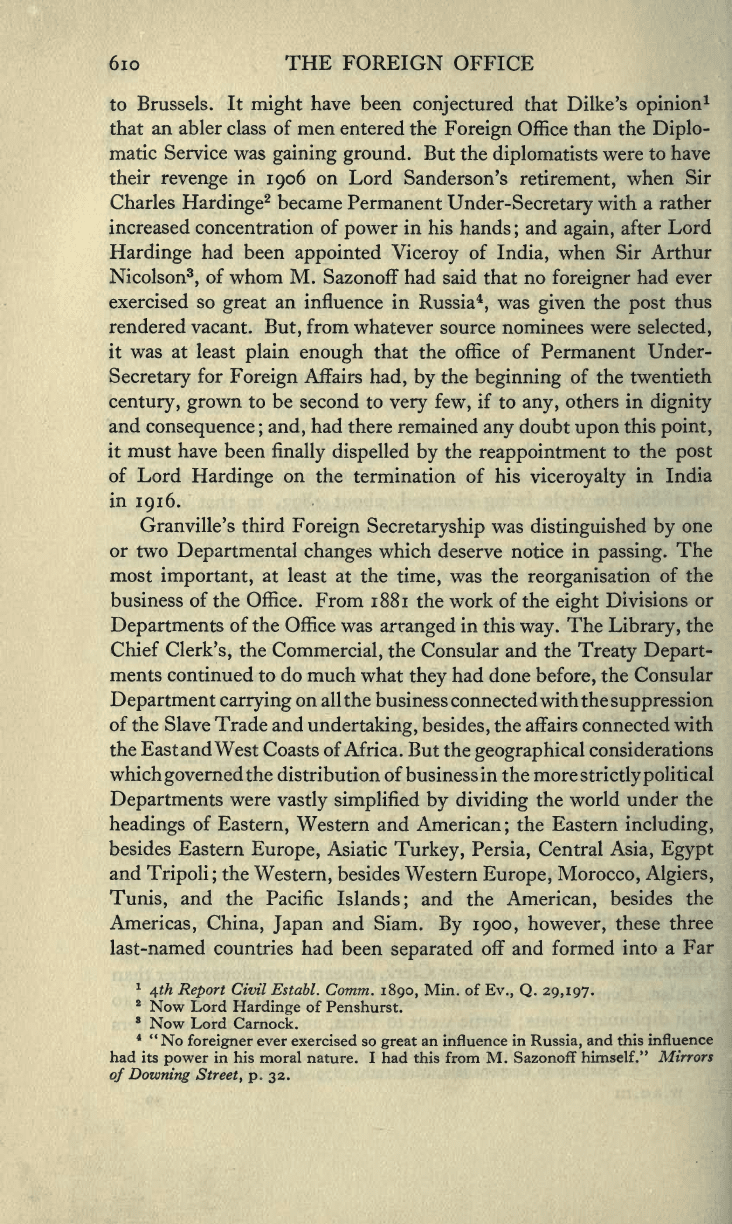
610
THE FOREIGN
OFFICE
to
Brussels.
It
might
have been
conjectured
that
Dilke's
opinion
1
that
an abler
class
of men
entered the
Foreign
Office than
the
Diplo-
matic
Service
was
gaining ground.
But
the
diplomatists
were
to
have
their
revenge
in
1906
on Lord
Sanderson's
retirement,
when
Sir
Charles
Hardinge
2
became
Permanent
Under-Secretary
with
a rather
increased
concentration
of
power
in his
hands
;
and
again,
after
Lord
Hardinge
had been
appointed
Viceroy
of
India,
when
Sir Arthur
Nicolson
3
,
of
whom M. Sazonoff had
said
that
no
foreigner
had
ever
exercised
so
great
an
influence
in
Russia
4
,
was
given
the
post
thus
rendered
vacant.
But,
from
whatever
source nominees were
selected,
it was at
least
plain
enough
that the
office
of
Permanent
Under-
Secretary
for
Foreign
Affairs
had,
by
the
beginning
of
the twentieth
century, grown
to be second
to
very
few,
if
to
any,
others
in
dignity
and
consequence
; and,
had
there remained
any
doubt
upon
this
point,
it must have been
finally dispelled by
the
reappointment
to
the
post
of Lord
Hardinge
on
the termination of his
viceroyalty
in India
in
1916.
Granville's
third
Foreign Secretaryship
was
distinguished
by
one
or
two
Departmental
changes
which
deserve
notice
in
passing.
The
most
important,
at least
at the
time,
was the
reorganisation
of the
business of
the
Office.
From
1881
the
work of the
eight
Divisions
or
Departments
of
the
Office was
arranged
in
this
way.
The
Library,
the
Chief
Clerk's,
the
Commercial,
the
Consular and
the
Treaty
Depart-
ments continued
to do much
what
they
had done
before,
the
Consular
Department
carrying
on all the
business connected with the
suppression
of
the
Slave
Trade and
undertaking,
besides,
the
affairs
connected
with
the
East
and
West
Coasts
of
Africa.
But
the
geographical
considerations
which
governed
the distribution of
business
in
the
more
strictly political
Departments
were
vastly simplified by
dividing
the
world under
the
headings
of
Eastern,
Western
and
American
;
the Eastern
including,
besides
Eastern
Europe,
Asiatic
Turkey,
Persia,
Central
Asia,
Egypt
and
Tripoli
;
the
Western,
besides
Western
Europe,
Morocco,
Algiers,
Tunis,
and
the
Pacific
Islands;
and
the
American,
besides the
Americas, China,
Japan
and
Siam.
By 1900,
however,
these
three
last-named countries had
been
separated
off
and
formed into
a
Far
1
4th Report
Civil
Establ.
Comm.
1890,
Min. of
Ev.,
Q.
29,197.
2
Now Lord
Hardinge
of
Penshurst.
8
Now Lord
Carnock.
4
"
No
foreigner
ever exercised
so
great
an
influence
in
Russia,
and this
influence
had
its
power
in
his moral
nature.
I had
this
from M. Sazonoff
himself."
Mirrors
of
Downing
Street,
p. 32.
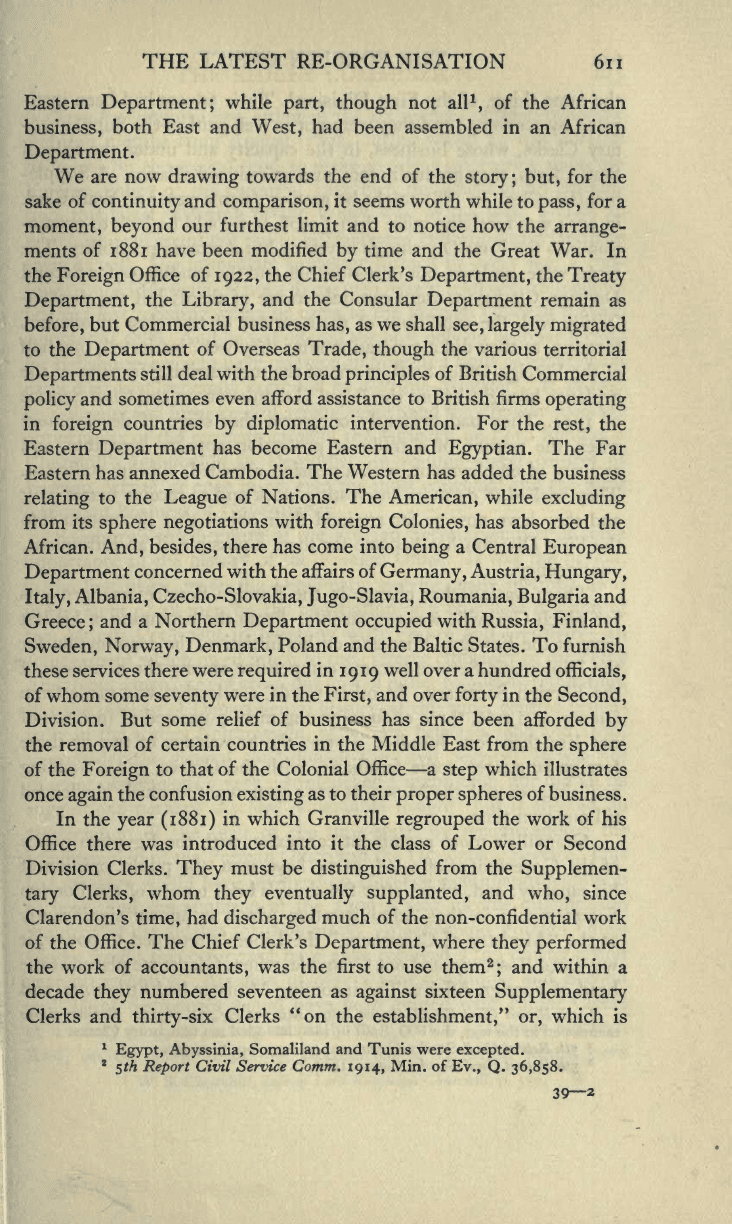
THE
LATEST RE-ORGANISATION
611
Eastern
Department;
while
part,
though
not
all
1
,
of
the
African
business,
both East
and
West,
had
been
assembled
in an African
Department.
We
are now
drawing
towards
the
end
of
the
story;
but,
for the
sake
of
continuity
and
comparison,
it
seems
worth while to
pass,
for a
moment,
beyond
our furthest
limit and
to notice how
the
arrange-
ments
of
1
88
1
have been
modified
by
time
and
the
Great
War. In
the
Foreign
Office
of
1922,
the
Chief Clerics
Department,
the
Treaty
Department,
the
Library,
and
the
Consular
Department
remain
as
before,
but
Commercial business
has,
as
we
shall
see,
largely
migrated
to the
Department
of
Overseas
Trade,
though
the various
territorial
Departments
still
deal
with the
broad
principles
of
British
Commercial
policy
and
sometimes
even afford assistance to
British firms
operating
in
foreign
countries
by diplomatic
intervention. For
the
rest,
the
Eastern
Department
has
become Eastern
and
Egyptian.
The
Far
Eastern
has
annexed
Cambodia.
The Western has added
the
business
relating
to the
League
of
Nations.
The
American,
while
excluding
from its
sphere
negotiations
with
foreign
Colonies,
has
absorbed
the
African.
And, besides,
there
has come
into
being
a
Central
European
Department
concerned with the
affairs
of
Germany,
Austria,
Hungary,
Italy,
Albania,
Czecho-Slovakia,
Jugo-Slavia,
Roumania,
Bulgaria
and
Greece;
and a Northern
Department occupied
with
Russia, Finland,
Sweden,
Norway,
Denmark,
Poland
and
the Baltic
States. To furnish
these
services
there
were
required
in
19
19
well
over
a
hundred
officials,
of
whom some
seventy
were
in
the
First,
and over
forty
in
the
Second,
Division. But
some
relief
of business
has
since been
afforded
by
the
removal of certain
countries
in
the
Middle
East from
the
sphere
of
the
Foreign
to that
of the Colonial
Office
—
a
step
which
illustrates
once
again
the
confusion
existing
as to their
proper
spheres
of
business.
In
the
year (1881)
in which Granville
regrouped
the work of
his
Office
there
was introduced
into
it
the class
of
Lower
or
Second
Division Clerks.
They
must
be
distinguished
from
the
Supplemen-
tary
Clerks,
whom
they eventually supplanted,
and
who,
since
Clarendon's
time,
had
discharged
much of
the non-confidential work
of
the
Office. The Chief Clerk's
Department,
where
they performed
the
work of
accountants,
was
the first to use
them
2
;
and
within
a
decade
they
numbered seventeen
as
against
sixteen
Supplementary
Clerks and
thirty-six
Clerks
"on
the
establishment," or,
which is
1
Egypt, Abyssinia,
Somaliland
and
Tunis were
excepted.
2
5th
Report
Civil Service Comm.
1914,
Min. of
Ev.,
Q.
36,858.
39—2
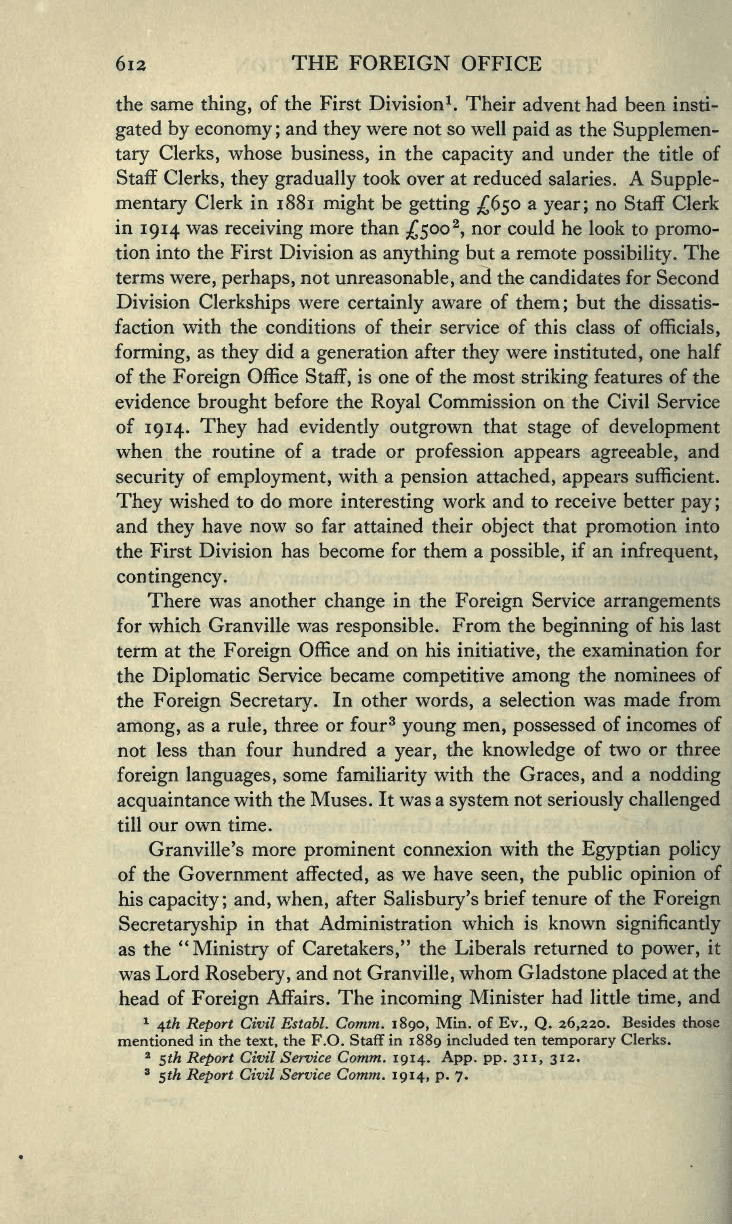
612
THE
FOREIGN
OFFICE
the
same
thing,
of
the First Division
1
.
Their
advent
had been insti-
gated
by economy
;
and
they
were not
so
well
paid
as
the
Supplemen-
tary
Clerks,
whose
business,
in
the
capacity
and
under
the
title
of
Staff
Clerks,
they gradually
took over at
reduced
salaries.
A
Supple-
mentary
Clerk
in
1881
might
be
getting £650
a
year;
no
Staff
Clerk
in
1914
was
receiving
more
than
£500
2
,
nor
could he look
to
promo-
tion
into
the
First Division
as
anything
but a
remote
possibility.
The
terms
were,
perhaps,
not
unreasonable,
and
the
candidates for Second
Division
Clerkships
were
certainly
aware of
them
;
but the
dissatis-
faction
with
the conditions
of
their
service
of
this
class of
officials,
forming,
as
they
did
a
generation
after
they
were
instituted,
one half
of
the
Foreign
Office
Staff,
is
one
of
the
most
striking
features
of
the
evidence
brought
before
the
Royal
Commission
on
the
Civil Service
of
1
9
14. They
had
evidently outgrown
that
stage
of
development
when the routine
of a
trade
or
profession
appears
agreeable,
and
security
of
employment,
with
a
pension
attached,
appears
sufficient.
They
wished to
do more
interesting
work
and
to
receive
better
pay
;
and
they
have
now
so far
attained their
object
that
promotion
into
the First
Division has become for
them
a
possible,
if
an
infrequent,
contingency.
There
was
another
change
in
the
Foreign
Service
arrangements
for
which Granville
was
responsible.
From
the
beginning
of his
last
term
at the
Foreign
Office and
on
his
initiative,
the examination
for
the
Diplomatic
Service became
competitive
among
the
nominees
of
the
Foreign
Secretary.
In
other
words,
a selection
was made
from
among,
as a
rule,
three
or four
3
young
men,
possessed
of incomes
of
not
less
than
four
hundred
a
year,
the
knowledge
of
two
or three
foreign languages,
some
familiarity
with
the
Graces,
and
a
nodding
acquaintance
with
the Muses. It
was a
system
not
seriously
challenged
till
our
own
time.
Granville's
more
prominent
connexion
with the
Egyptian
policy
of
the
Government
affected,
as we
have
seen,
the
public opinion
of
his
capacity;
and, when,
after
Salisbury's
brief tenure
of
the
Foreign
Secretaryship
in
that Administration
which
is known
significantly
as
the
"Ministry
of
Caretakers,"
the
Liberals returned to
power,
it
was Lord
Rosebery,
and
not
Granville,
whom
Gladstone
placed
at the
head
of
Foreign
Affairs. The
incoming
Minister
had
little
time,
and
1
\ih
Report
Civil Establ. Comm.
1890,
Min.
of
Ev.,
Q.
26,220.
Besides those
mentioned
in
the
text,
the F.O. Staff
in
1889
included
ten
temporary
Clerks.
2
5th
Report
Civil Service Comm.
1914.
App.
pp.
311,
312.
3
$th Report
Civil Service
Comm.
19 14, p.
7.
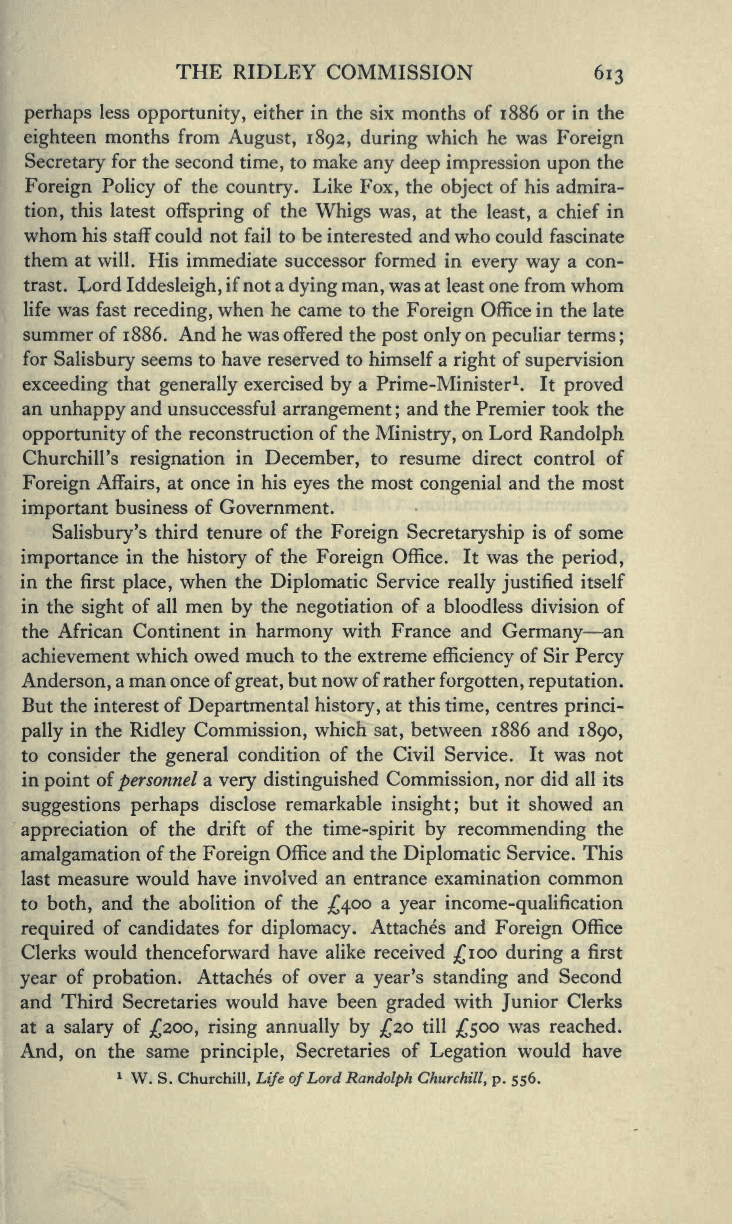
THE
RIDLEY
COMMISSION
613
perhaps
less
opportunity,
either
in
the
six
months
of 1886
or in
the
eighteen
months
from
August, 1892,
during
which
he
was
Foreign
Secretary
for
the
second
time,
to make
any
deep impression upon
the
Foreign
Policy
of
the
country.
Like
Fox,
the
object
of
his admira-
tion,
this
latest
offspring
of the
Whigs
was,
at the
least,
a chief
in
whom his
staff could not fail
to
be
interested and who
could fascinate
them
at
will. His
immediate successor formed in
every way
a con-
trast.
Lord
Iddesleigh,
if
not
a
dying
man,
was
at least one
from whom
life was
fast
receding,
when he came
to
the
Foreign
Office
in
the late
summer of
1886.
And
he
was
offered
the
post
only
on
peculiar
terms
;
for
Salisbury
seems to
have
reserved to himself
a
right
of
supervision
exceeding
that
generally
exercised
by
a
Prime-Minister
1
.
It
proved
an
unhappy
and unsuccessful
arrangement
;
and
the Premier
took
the
opportunity
of
the
reconstruction
of
the
Ministry,
on Lord
Randolph
Churchill's
resignation
in
December,
to resume
direct control
of
Foreign
Affairs,
at once
in
his
eyes
the
most
congenial
and
the
most
important
business of
Government.
Salisbury's
third tenure
of
the
Foreign
Secretaryship
is of
some
importance
in
the
history
of the
Foreign
Office.
It was
the
period,
in
the
first
place,
when
the
Diplomatic
Service
really justified
itself
in
the
sight
of all men
by
the
negotiation
of a
bloodless division of
the
African
Continent
in
harmony
with France
and
Germany
—
an
achievement
which owed
much
to the extreme
efficiency
of
Sir
Percy
Anderson,
a man
once of
great,
but
now
of
rather
forgotten, reputation.
But
the interest
of
Departmental history,
at
this
time,
centres
princi-
pally
in
the
Ridley
Commission,
which
sat,
between 1886 and
1890,
to
consider the
general
condition
of
the
Civil
Service.
It
was
not
in
point
of
personnel
a
very
distinguished
Commission,
nor did
all
its
suggestions
perhaps
disclose remarkable
insight;
but it showed
an
appreciation
of
the
drift
of
the
time-spirit by
recommending
the
amalgamation
of
the
Foreign
Office and
the
Diplomatic
Service.
This
last
measure would
have
involved
an
entrance examination
common
to
both,
and
the
abolition
of
the
£400
a
year
income-qualification
required
of
candidates
for
diplomacy.
Attaches
and
Foreign
Office
Clerks would
thenceforward
have
alike
received
£100
during
a
first
year
of
probation.
Attaches
of
over
a
year's
standing
and Second
and Third
Secretaries
would
have been
graded
with
Junior
Clerks
at
a
salary
of
£200,
rising
annually by £20
till
£500
was
reached.
And,
on
the
same
principle,
Secretaries
of
Legation
would
have
1
W.
S.
Churchill,
Life of
Lord
Randolph
Churchill,
p. 556.
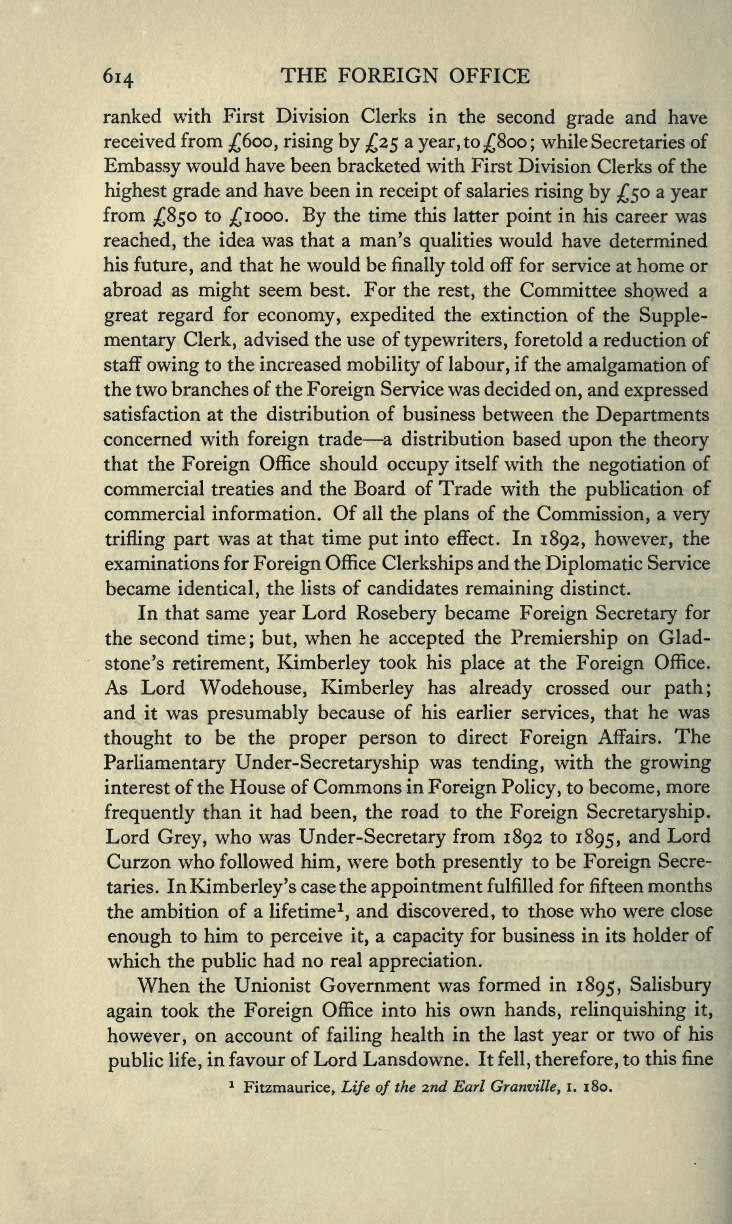
6i
4
THE
FOREIGN
OFFICE
ranked
with
First Division Clerks in
the
second
grade
and
have
received
from
£600, rising by
£25
a
year,
to
£800;
while
Secretaries
of
Embassy
would have been
bracketed
with
First
Division Clerks of the
highest
grade
and
have been
in
receipt
of
salaries
rising
by
£50
a
year
from
£850
to
.£1000. By
the time this latter
point
in
his
career was
reached,
the
idea
was
that
a man's
qualities
would
have
determined
his
future,
and
that
he would be
finally
told
off for
service
at
home or
abroad as
might
seem best.
For
the
rest,
the
Committee showed
a
great regard
for
economy,
expedited
the
extinction
of
the
Supple-
mentary
Clerk,
advised
the
use of
typewriters,
foretold a
reduction
of
staff
owing
to the
increased
mobility
of
labour,
if
the
amalgamation
of
the two
branches
of
the
Foreign
Service was decided
on,
and
expressed
satisfaction at the distribution
of
business
between
the
Departments
concerned
with
foreign
trade
—
a
distribution based
upon
the
theory
that the
Foreign
Office
should
occupy
itself
with the
negotiation
of
commercial
treaties
and
the
Board
of Trade
with
the
publication
of
commercial information.
Of all
the
plans
of
the
Commission,
a
very
trifling
part
was
at that time
put
into
effect.
In
1892,
however,
the
examinations for
Foreign
Office
Clerkships
and
the
Diplomatic
Service
became
identical,
the lists
of
candidates
remaining
distinct.
In that
same
year
Lord
Rosebery
became
Foreign
Secretary
for
the second time
; but,
when
he
accepted
the
Premiership
on Glad-
stone's
retirement,
Kimberley
took his
place
at the
Foreign
Office.
As
Lord
Wodehouse,
Kimberley
has
already
crossed
our
path;
and
it
was
presumably
because
of his
earlier
services,
that
he
was
thought
to
be the
proper person
to
direct
Foreign
Affairs.
The
Parliamentary
Under-Secretaryship
was
tending,
with the
growing
interest
of
the
House
of
Commons
in
Foreign
Policy,
to
become,
more
frequently
than
it
had
been,
the
road
to the
Foreign
Secretaryship.
Lord
Grey,
who
was
Under-Secretary
from
1892
to
1895,
and
Lord
Curzon who
followed
him,
were both
presently
to be
Foreign
Secre-
taries. In
Kimberley's
case the
appointment
fulfilled for
fifteen
months
the ambition
of a
lifetime
1
,
and
discovered,
to those
who
were
close
enough
to
him to
perceive
it,
a
capacity
for
business in its
holder
of
which
the
public
had
no real
appreciation.
When the
Unionist
Government was
formed
in
1895,
Salisbury
again
took
the
Foreign
Office into
his own
hands,
relinquishing
it,
however,
on
account
of
failing
health
in
the last
year
or
two
of
his
public
life,
in
favour
of
Lord Lansdowne.
It
fell, therefore,
to
this fine
1
Fitzmaurice, Life of
the 2nd
Earl
Granville,
1. 180.
